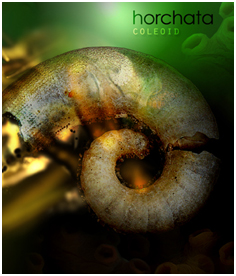[reviews]
afe096lcd
horchata: coleoid
magazine, usa, july 2007
Maybe you haven't heard of Horchata, but he's pretty big in Europe. Really, he is. Germany, Italy, France - they all adore the dirgeful, dark, illbient sounds created by Michael Palace, released under the garb of his Horchata pseudonym.
His most recent CD, "Coleoid" (Afe Records) is filed under "dark ambient", and can safely be described as almost antimusic, withouth any truly discernible beat or steady rhythm to grab hold of. Rather, it moves continuously, carrying a life of its own, meandering slowly and softly like the droning sound of your subconscious as you descend into the unknowable.
"Coleoid" is a one-hour long immersion into the aural depiction of its namesake. Coleoids are a group of intelligent, invertebrate cephalopods that can withstand the extreme depths of the ocean, enduring perpetual darkness and pressure. "Coleoid"'s four tracks, "Manus", "Dactylus", "Tentacular" and "Cirri", built upon samples, field recordings, reverbs and delays, create a hazy, soporific world with low frequencies growling underneath audible sonic layers.
The whole album creates a reverberating hum, as though it's tuned into the metaphysical structure of your chakras. "My intention is to develop a soundscape that expresses the niche of ecotype that a group of organisms live in", says Horchata/Michael Palace.
Largely informed by his work as a research scientist at the Complex System Research Center at the Institute of Earth, Ocean and Space, the compositions from Horchata are shaped, in part, by metereology, biogeochemistry, hydrology and forest dynamics. Using analog synthesizers, digital synths, soft synths, his own programmed sound design tools, samples and field recordings of insects, frogs, birds and various Amazonian creatures garnered from his studies in the rainforest, Horchata constructs soundscapes that brod, breathe, slither and glide. Think Boards of Canada or We.
With a discography of close to 40 albums and past collaborations with Twine, Ocosi, Miles Tilmann, Narc and Zenopede, Horchata has an unduly impressive resume. So, why hasn't he become a household name, in the Seacost? Says Palace, "Europe is much more expansive in their tastes for electronic music, while most people in the U.S. associate electronic music with a techno or house genre. Drum'n'bass is fairly popular in the U.S. and some labels like Ohm Resistance are putting out some great and unique music. I Have been on the fringe of the noise, industrial and dark ambient genres, though at times I think that my music is miles apart from these genres".
No, you definitely can't dance to it, but "Coleoid" will move you all the same.
[Rebecca Cox]
